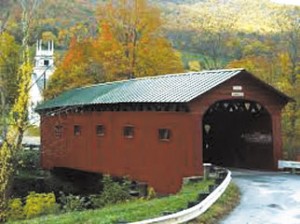Built for practicality, but now preserved as a piece of our history, the covered bridges of America stand as a tribute to the craftsmanship and diligence of their creators.
Time, neglect and the elements have gradually chiseled away at the abundance of bridges in the U.S., dropping the number from an estimated 12,000 in the mid 1800s to only 1,500 by 1950. Progress also took its toll. While wooden bridges were common from 1805-1895, construction ceased shortly after the turn of the century as stronger, more cost effective metal truss bridges were erected, leaving the old wooden bridges abandoned.
Each fall, the people of Parke County extend an invitation to all of us to come share in their heritage as they host the Parke County Covered Bridge Festival. This marks the 58th year for the event which runs October 14-23. From homemade pies, apple butter and BBQ to the work of local artisans and musicians, this is Hoosier hospitality at it best.
Living up to its title as “The Covered Bridge Capital of the World,” the county is home to 30 of the remaining 98 bridges in Indiana. Most of these date from 1875-1895 and thanks to the efforts of the National Society for the Preservation of Covered Bridges, all but 10 are vehicle accessible.
The headquarters for the festival is located in the 1883 train depot on the Rockville, Indiana courthouse lawn. There you can find information on the Covered Bridge Art Gallery and the Historic Ritz Theater, as well as local accommodations, restaurants and bus tours. The charming brick lined streets of Rockville are home to a cluster of antique shops and local bands are featured each day on the town square.
In all, nine communities comprise the county-wide festival, each with their own unique contribution to the history of Parke County. Two of the most visited bridges are the ones located in Bridgeton and McAllister. The McAllister, built in 1914, is 144 feet long and is open to traffic. The original Bridgeton Bridge was an impressive 245 foot long double span Burr Arch structure built in 1868. Due to deterioration it was deemed unsafe and closed to traffic in 1968. On April 28, 2005 the community was devastated when it was destroyed by arsonists. The Bridgeton Bridge that you will visit today was built in 2006 by local citizens, with assistance from the state of Indiana.
In addition to the bridges, there are two things that top of my “must do” list when I venture to Parke County The first is a stop at the Bridgeton Mill to grab some of the stone ground flour and corn meal. The second is to take a drive to 4080W and State Road 340, just west of Brazil, where you will find several miles of roadside vendors with vintage, antique and primitive treasures for sale.
For all of you covered bridge enthusiasts, let me leave you with a bit of trivia. Ever wonder why early bridges were covered and painted red? Travel during the time these bridges were built was by horseback or horse-drawn carriage. Horses are, by nature, afraid of both height and fast-flowing water. With their shape, enclosed structure and red paint, the horse thought he was entering a barn, and remained calm.
To plan your trip in advance visit www.coveredbridges.com online or contact the event coordinators by e-mail at info@coveredbridges.com for a map of the county with marked covered bridge routes, lodging listings, and scheduled events for each of the participating towns. Until next time…Linda
Irvington resident Linda Kennett is a professional liquidation consultant specializing in down-sizing for seniors and the valuation of estates and may be reached at 317-258-7835 or lkennett@indy.rr.com



